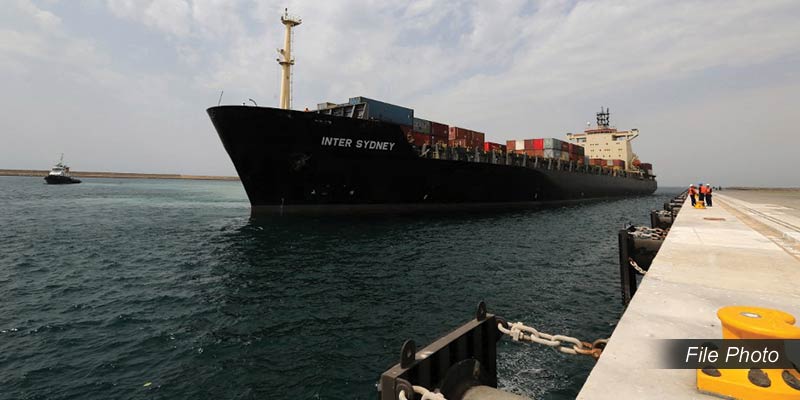- India
- Jul 31
- Kevin Savio Antony
Explainer - Significance of Chabahar Port
• Union Minister of Road Transport and Highways Nitin Gadkari attended the inauguration ceremony of Iran’s President Masoud Pezeshkian in Tehran on July 30 in reflection of close ties between the two countries.
• Pezeshkian was sworn-in as Iran’s ninth president over three weeks after he defeated Saeed Jalili in a run-off election.
• The Presidential election was necessitated following the death of President Ebrahim Raisi in a helicopter crash in May.
• During Gadkari’s interactions in Iran, both sides positively assessed the state of bilateral relations, including cooperation on the development of Chabahar Port.
• Both sides underscored that Chabahar Port would contribute to strengthening bilateral and regional trade.
Chabahar Port
• Located in the Sistan-Balochistan province on the energy-rich Iran’s southern coast, the Chabahar port is being developed by India and Iran to boost connectivity and trade ties.
• The strategic location of Chabahar has a great advantage for developing it as a trans-shipment hub.
• It is located on the Indian Ocean in the Sistan and Baluchistan province of Iran.
• The Port’s deep draft of 16m is suitable for handling large shipment vessels.
• The Port lies close to some of the busiest trade routes in the world. The region comes under the Asia-Europe, Asia-Asia trade route, which carries large cargo volumes.
Significance of Chabahar Port for India:
• India has been pushing for the Chabahar port project to boost regional trade, especially for its connectivity to Afghanistan.
• The port, which is easily accessible from India’s western coast, is increasingly seen as a counter to Pakistan’s Gwadar port, which is being developed with Chinese investment.
• Zaranj-Delaram road constructed by India in 2009 can give access to Afghanistan’s Garland Highway, setting up road access to four major cities in Afghanistan — Herat, Kandahar, Kabul and Mazar-e-Sharif.
• India and Iran have projected the port as a key hub for the International North–South Transport Corridor (INSTC) project.
• The INSTC is a 7,200-km-long multi-mode transport project for moving freight among India, Iran, Afghanistan, Armenia, Azerbaijan, Russia, Central Asia and Europe.
• India has been developing a part of Chabahar Port and discussions on the development of the port date back to 2003 during Iranian President Muhammad Khatami’s visit to India.
• In 2013, India committed to investing $100 million towards the development of Chabahar Port.
• A memorandum of understanding (MoU) for development of Chabahar Port by India was signed in May 2015. Thereafter, the contract was executed on May 23, 2016, at Tehran (Iran) during the visit of Prime Minister Narendra Modi to Iran.
• Chabahar is an oceanic port. By leveraging Chabahar Port, India aims to bypass Pakistan and establish direct access to Afghanistan and beyond, into Central Asia.
• Kandla Port in Gujarat is the closest to the Chabahar Port at 550 nautical miles while the distance between Chabahar and Mumbai is 786 nautical miles.
• The operations continued through short-term contracts while negotiations on the long-term agreement picked pace with the visit of Sonowal to Chabahar in August 2022.
• Chabahar Port was used by India in 2023 to send 20,000 tonnes of wheat aid to Afghanistan. In 2021, the same was used to supply environmentally friendly pesticides to Iran.
• This is the first time India will take over the management of an overseas port that will also have a multiplier effect on trade among India, Iran and Afghanistan as efforts continue to directly tap the potential in Central Asia, bypassing neighbouring Pakistan.
Challenges in realising potential of Chabahar Port
• Concern of US with Iran: The US has warned India of the risk of possible sanctions after New Delhi signed a pact with Iran on Chabahar Port. On May 8, 2018, the then US President Donald Trump announced his decision to cease the country’ participation in the Joint Comprehensive Plan of Action (JCPOA) with Iran and to begin re-imposing the US nuclear-related sanctions that were lifted to effectuate the JCPOA sanctions relief, following a wind-down period.
The sanctions can be either comprehensive or selective, using the blocking of assets and trade restrictions to accomplish foreign policy and national security goals.
The US has provided a rare exemption to India from sanctions on the Chabahar Port in Iran.
India has maintained that the Iranian nuclear issue should be resolved through dialogue and diplomacy by respecting Iran’s right to peaceful uses of nuclear energy as also the international community’s strong interest in the exclusively peaceful nature of Iran’s nuclear programme.
• Security Concerns: The Houthi rebels’ potential to disrupt sea lanes in the Red Sea can affect maritime traffic, posing a threat to the operations at Chabahar Port.
• Terrorism and Piracy: The threat of terrorism and piracy in the region requires significant security measures to ensure safe maritime trade.
Competition from Alternative Trade Routes:
• India-Middle East-Europe Economic Corridor (IMEC): The IMEC and other emerging transport routes pose significant competition, offering alternative pathways that might be more secure or cost-effective.
• China’s Belt and Road Initiative (BRI): The BRI, particularly the China-Pakistan Economic Corridor (CPEC), provides robust competition, potentially diverting trade away from Chabahar.
Infrastructure and Investment Needs:
• Limited Development: The port requires substantial infrastructure development, including modern facilities, efficient logistics, and transportation networks.
• Investment Constraints: Due to international sanctions and political instability, attracting foreign investment remains challenging.
• Diplomatic Challenges: India needs to balance its diplomatic relations with Iran, the US, and other regional powers, which can be a delicate and complex task.
• International Cooperation: Ensuring cooperation among regional stakeholders is crucial for the smooth operation and development of Chabahar Port.
(The author is a trainer for Civil Services aspirants.)

